System Dynamics and Sustainable Solution: The Case in a Large-Scale Pallet Manufacturing Company
Abstract
:1. Introduction
Literature Review
2. Materials and Methods
2.1. System Dynamics Stage
2.2. Multicriteria Decision Making
- WS—wood storage (units); refers to the quantity of wood available in the organization coming mainly from Mexico cut into pieces in the measurements required for the pallets.
- WF—wood with fungus (units); considered as a high risk if assembled as pallets due to the effect of the humidity captured during transportation, since the pallet may reach its destination with fungi due to its sensitivity. Upon arrival, wood is treated with an established cleaning process by the company.
- WC—wood clean (units). Clean wood refers to the total quantity of wood ready to be assembled to make the pallets.
- AP—the pallets assembled from the wooden pieces required for their production.
- IPW—inventory in the pallet warehouse (units); refers to the inventory of the pallets generated and stored in the warehouse for its distribution.
- SI—sawdust inventory (tons); refers to the quantity of sawdust generated as part of the planning process of the wooden pieces, which represents a loss but that is used and sold as a secondary product.
- TPC—total pallets per client (units); refers to the total quantity of pallets assigned to the clients of the organization.
- CI—cash inflow (MXN); refers to the daily money income in the organization, of which the production cost has been deducted (data not available because of confidentiality); thus, the sale price generates the organization utility.
3. Results
3.1. Mapping the Supply Chain of Pallet Manufacturing
3.2. Creating the Causal Diagram from the Dynamics Hypotheses
- Hd1: the wood for pallet construction depends on availability and permits to cut pine trees in the cities that offer this product;
- Hd2: the amount of pellet production depends on the final client from the operation rules of 30% assigned only for the local supplier;
- The wooden quantity in the inventory depends on the pallet demand to ship beer to the final client.
3.3. Creating Flow and Level Diagrams with the Model Equations
Waste) × dt
(Warehousing_Finished_product − Final_brushing) × dt
(Final_brushing − loading_pallets_on_trucks) × dt
3.4. Simulation and Validation of the Current Scenario
3.5. Building the Graphical Interface with the User
3.6. Evaluating Scenarios: Normal, Optimistic, and Pessimistic Using Multicriteria Decision Making
- Optimistic scenario. The overall value obtained with TOPSIS was 0.6069, given in optimistic scenario 5 and classified in range 2.
- Pessimistic scenario. The value generated with TOPSIS was 0.5400 for pessimistic scenario 2, classified in rank 8.
- Current scenario. The value generated with TOPSIS was 0.6793 for current scenario 5, ranked 1.
- Optimistic scenario: the overall value with FUCA was 5.5, given in optimistic scenario 5 and classified in rank 2.
- Pessimistic scenario: the value generated with FUCA was 7.50 for pessimistic scenario 2, ranked 8.
- Current scenario: the value generated with the FUCA was 5.65 for the current scenario 5, classified in rank 1.
4. Discussion
5. Conclusions
Author Contributions
Funding
Institutional Review Board Statement
Informed Consent Statement
Data Availability Statement
Acknowledgments
Conflicts of Interest
Appendix A. Equations, Properties, and Units
| Equation | Properties | Units |
| Assembly_of_pallets(t)=Assembly_of_pallets (t-dt) + (“Entry-assembly_flow_of_pallets”- towards_sealing- Waste) × dt | INIT Assembly_of_pallets = 0 | pallet |
| Conveyor_to_distrubution_of_pallets(t)=Conveyor_to_distrubution_of_pallets (t-dt) + (Final_brushing -loading_of_pallets_on_trucks) × dt | INIT Conveyor_to_distrubution_of_pallets = 0 TRANSIT TIME = 1 CAPACITY = 30,000 CONTINUOUS ACCEPT MULTIPLE BATCHES | pallet |
| Conveyor_to_storage_of_pallets(t) = Conveyor_to_storage_of_pallets (t-dt) + (output_1_to_storage_of_pallets + output_2_yo_storage_of_pallets-Warehousing_of_Finished_product) × dt | INIT Conveyor_to_storage_of_pallets = 1 TRANSIT TIME = 0.03 CONTINUOUS ACCEPT MULTIPLE BATCHES | pallet |
| Inventory_in_pallet_warehouse(t) = Inventory_in_pallet_warehouse (t-dt) + (Warehousing_of_Finished_product-Final_brushing) × dt | INIT Inventory_in_pallet_warehouse = 0 | pallet |
| Inventory_in_transit(t) = inventory_in_transit (t - dt) + (pallets_in_trucks - final_client) × dt | INIT inventory_in_transit = STEP(1,RANDOM (3100, 3200)) COOK TIME = 1 CAPACITY = 3200 FILL TIME = 0.3 ACCEPT SINGLE BATCHSPLIT BATCHES | pallet |
| Loading_trucks(t) = Loading_trucks (t - dt) + (loading_of_pallets_on_trucks - pallets_in_trucks) × dt | INIT Loading_trucks = 0 | pallet |
| Oven_1(t) = Oven_1(t-dt) + (Output_to_oven_1-output_1_to_storage_of_pallets) × dt | INIT Oven_1 = 0 COOK TIME = 1 CAPACITY = 10,000 FILL TIME = 0.03 ACCEPT SINGLE BATCHSPLIT BATCHES | pallet |
| Oven_2(t) = Oven_2(t-dt) + (Output_to_oven_2-output_2_yo_storage_of_pallets) × dt | INIT Oven_2 = 0 COOK TIME = 1 CAPACITY = 30,000 FILL TIME = 0.03 ACCEPT SINGLE BATCHSPLIT BATCHES | pallet |
| Queue_1(t) = Queue_1(t-dt) + (arrival_at_sealing_pallets-Output_to_oven_1-Output_to_oven_2) × dt | INIT Queue_1 = 0 | pallet |
| Sawdust_Inventory(t) = Sawdust_Inventory(t-dt) + (Sawdust) × dt | INIT Sawdust_Inventory = 0 | ton sawdust |
| Total_pallets_for_clients(t) = Total_pallets_for_clients(t-dt) + (final_client-Sales) × dt | INIT Total_pallets_for_clients = 0 | pallet |
| Transfer_to_sealing(t) = transfer_to_sealing (t-dt) + (towards_sealing-arrival_at_sealing_pallets) × dt | INIT transfer_to_sealing = 0 TRANSIT TIME = 1 CAPACITY = 30,000 CONTINUOUS ACCEPT MULTIPLE BATCHES | pallet |
| Washing_in_chlorine(t) = Washing_in_chlorine (t-dt) + (output_of_wood_lots-chlorination) × dt | INIT Washing_in_chlorine = 0 COOK TIME = 0.3 CAPACITY = 3200 FILL TIME = 0.1 ACCEPT SINGLE BATCHSPLIT BATCHES | ft-wood |
| Wood_brushing(t) = Wood_brushing (t-dt) + (cleaning - brushing) × dt | INIT Wood_brushing = 0 TRANSIT TIME = 1 CAPACITY = 3000 CONTINUOUS ACCEPT MULTIPLE BATCHES | ft-wood |
| Wood_Clean(t) = Wood_Clean (t-dt) + (Incoming_flow_of_clean_wood) × dt | INIT Wood_Clean = 0 | ft-wood |
| Wood_lots(t) = wood_lots (t-dt) + (brushing-oupu_of_wood_lots) × dt | INIT wood_lots = 0 | ft-wood |
| Wood_storage(t) = Wood_storage(t-dt) + (Wooden_wood-Output_to_production) × dt | INIT Wood_storage = 0 | ft-wood |
| Woods_with_fungus(t) = Woods_with_fungus (t-dt) + (“FE-Wood_with_fungus”-cleaning) × dt | INIT Woods_with_fungus = 0 | ft-wood |
| arrival_at_sealing_pallets = CONVEYOR OUTFLOW | ATTRIBUTE VALUE = time_of_arrival_sealed | pallet/day |
| Brushing = CONVEYOR OUTFLOW | ATTRIBUTE VALUE = arrival_time | ft-wood/day |
| Chlorination = OVEN OUTFLOW | None | ft-wood/day |
| Cleaning = Woods_with_fungus x ”%_of_wood” | None | ft-wood/day |
| “Entry-assembly_flow_of_pallets” = Wood_Clean/ft_of_wood_per_pallet | None | pallet/day |
| “FE-Wood_with_fungus” = Output_to_production × ”%_wood_with_fungus” | None | ft-wood/day |
| Final_brushing = Inventory_in_pallet_warehouse/rate_of_wood_brushed | None | pallet/day |
| final_client = OVEN OUTFLOW | None | pallet/day |
| Incoming_flow_of_clean_wood = “%_clean_wood” × (Output_to_production + chlorination) | None | ft-wood/day |
| loading_of_pallets_on_trucks = CONVEYOR OUTFLOW | ATTRIBUTE VALUE = Truck_loading_time | pallet/day |
| output_of_wood_lots = QUEUE OUTFLOW | None | ft-wood/day |
| output_1_to_storage_of_pallets = OVEN OUTFLOW | INFLOW PRIORITY: 1 | pallet/day |
| output_2_yo_storage_of_pallets = OVEN OUTFLOW | INFLOW PRIORITY: 2 | pallet/day |
| Output_to_oven_1 = QUEUE OUTFLOW | OUTFLOW PRIORITY: 1 | pallet/day |
| Output_to_oven_2 = QUEUE OUTFLOW | OUTFLOW PRIORITY: 2 | pallet/day |
| Output_to_production = Wood_storage x Output_rate | None | ft-wood/day |
| pallets_in_trucks = QUEUE OUTFLOW | None | pallet/day |
| Sales = Total_pallets_for_clients/Delivery_time_pallets | None | pallet/day |
| Sawdust = Waste x Convertion_rate | None | ton sawdust/day |
| towards_sealing = Assembly_of_pallets/sealing_time | OUTFLOW PRIORITY: 1 | pallet/day |
| Warehousing_of_Finished_product = CONVEYOR OUTFLOW | None | pallet/day |
| Waste = Assembly_of_pallets x Waste_rate | OUTFLOW PRIORITY: 2 | pallet/day |
| Wooden_wood = IF Diference < 38,752 THEN Orders_amount/Delivery_time ELSE keep_minimum_inventories | None | ft-wood/day |
| “%_clean_wood” = RANDOM (0.21, 1) | None | dmnl |
| “%_of_wood” = RANDOM (0.7, 0.8) | None | 1/day |
| “%_wood_with_fungus” = RANDOM (0.02, 0.2) | None | dmnl |
| arrival_time = POISSON(1,0.4555, 1, 3200) | None | 1/day |
| cash_inflows = Sales*Sales_price_per_pallet | None | USD/day |
| Convertion_rate = 0.001 | None | ton steelrin/pallet |
| Delivery_time = 2 | None | day |
| Delivery_time_pallets = RANDOM (1, 2) | None | day |
| Difference = Storage_capacity-Wood_storage | None | ft-wood |
| ft_of_wood_per_pallet = 12.11 | None | ft-wood/pallet*day |
| keep_minimum_inventories = 38,752 | None | ft-wood/day |
| Orders_amount = 10,000 | None | ft-wood |
| Output_rate = 0.8 | None | 1/day |
| rate_of_wood_brushed = RANDOM (1, 2) | None | day |
| Sales_price_per_pallet = 260 | None | USD/pallet |
| sealing_time = 1 | None | day |
| Storage_capacity = 38,752 | None | ft-wood |
| time_of_arrival_sealed = POISSON(1, 0.4555, 1, 3200) | None | 1/day |
| Truck_loading_time = POISSON(1, 0.4555, 1, 3200) | None | day |
| Waste_rate = 0.2 | None | 1/day |
Appendix B. Macros Used to Determine TOPSIS Ranking
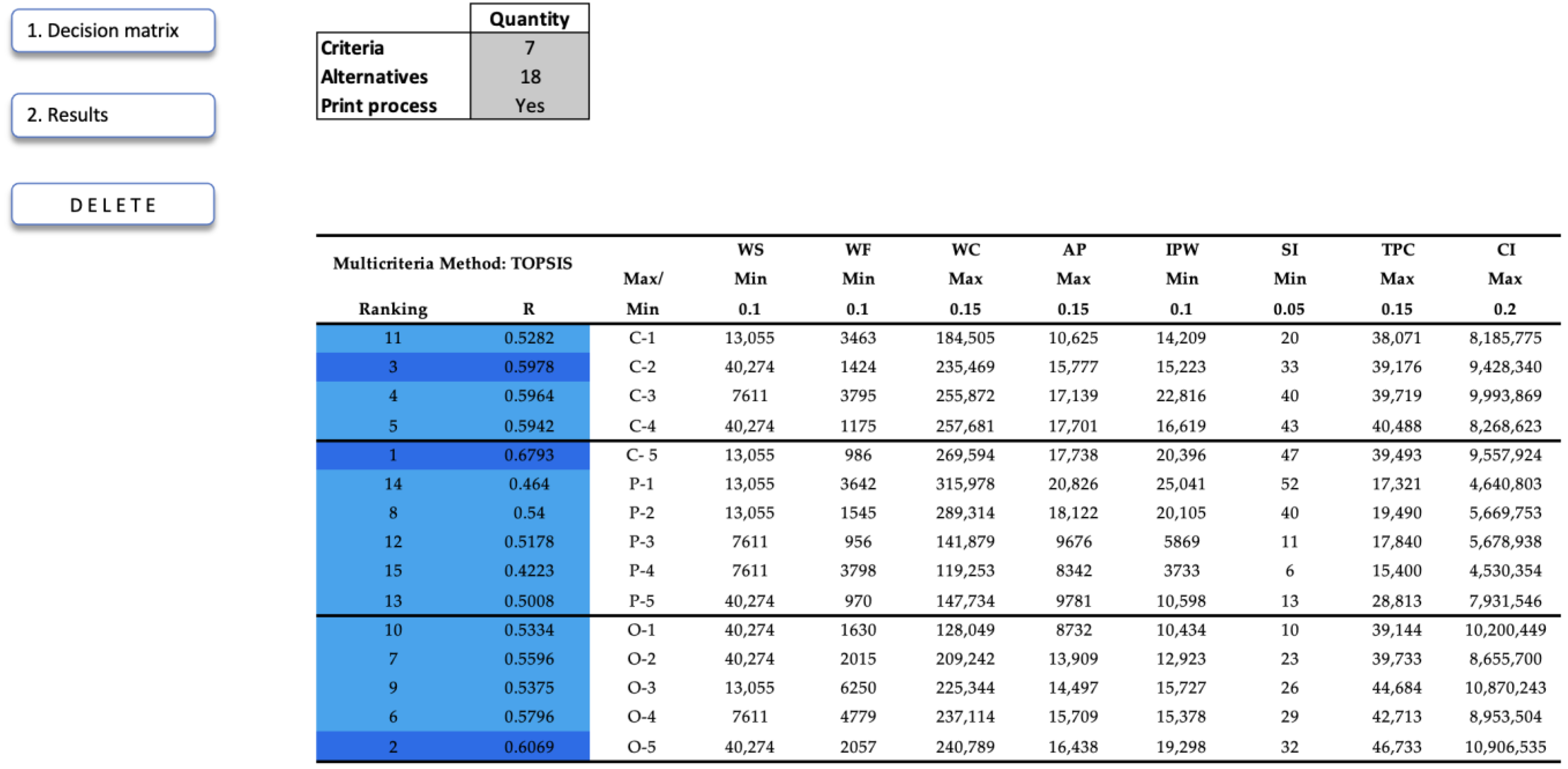
Appendix C. Macros Used to Determine FUCA Ranking

Appendix D. Model Tested under Extreme Conditions Using the Order Rate = 0
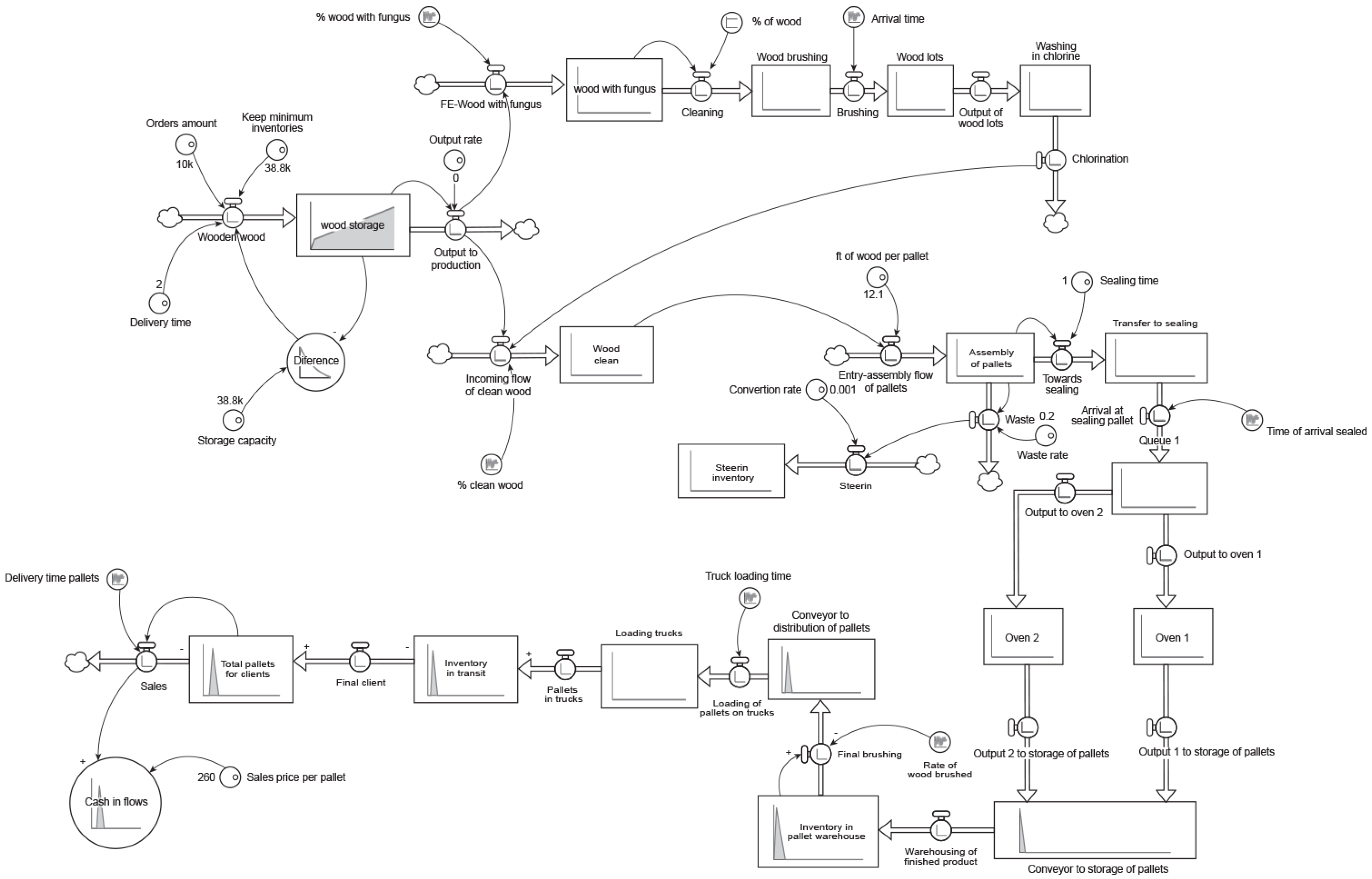
References
- Pedroso, C.B.; Tate, W.L.; da Silva, A.L.; Carpinetti, L.C.R. Supplier development adoption: A conceptual model for triple bottom line (TBL) outcomes. J. Clean. Prod. 2021, 314, 127886. [Google Scholar] [CrossRef]
- Silver, E.A.; Pyke, D.F.; Peterson, R. Inventory Management and Production Planning and Scheduling, 3rd ed.; Wiley: Chichester, UK, 1998. [Google Scholar]
- Forrester, J. Dinámica Industrial, 2nd ed.; El Ateneo: Buenos Aires, Argentina, 1981. [Google Scholar]
- Senge, P. La Quinta Disciplina, 2nd ed.; Granica: Buenos Aires, Argentina, 2005. [Google Scholar]
- Aracil, J.; Gordillo, F. Dinámica de Sistemas; Alianza: Madrid, Spain, 1997. [Google Scholar]
- Richardson, G.; Pugh, A., III. Introduction to System Dynamics Modeling with Dynamo. J. Oper. Res. Soc. 1997, 48, 1146. [Google Scholar] [CrossRef]
- Richmond, B. Introduction to System Thinking, STELLA®; Isse Systems: Lebanon, NH, USA, 2013; ISBN 100970492111. Available online: https://iseesystems.com/store/books/intro-systems-thinking/ (accessed on 20 April 2023).
- Chapra, S.; Canale, R. Numerical Methods for Engineers, 7th ed.; Mc Graw Hill Education: New York, NY, USA, 2015. [Google Scholar]
- Kleijnen, J. Verification and validation of simulation models. Eur. J. Oper. Res. 1995, 82, 145–162. [Google Scholar] [CrossRef] [Green Version]
- Barlas, Y.; Carpenter, S. Philosophical roots of model validation: Two paradigms. Syst. Dyn. Rev. 1990, 6, 148–166. [Google Scholar] [CrossRef]
- Schwartz, P. The Art of the Long View: “Planning for the Future in an Uncertain World”; Currency Doubleday: New York, NY, USA, 1996. [Google Scholar]
- Fernando, M.M.L.; Escobedo, J.L.P.; Azzaro-Pantel, C.; Pibouleau, L.; Domenech, S.; Aguilar-Lasserre, A. Selecting the best portfolio alternative from a hybrid multi objective GA-MCDM approach for New Product Development in the pharmaceutical industry. In Proceedings of the IEEE Symposium on Computational Intelligence in Multicriteria Decision-Making (MDCM), Paris, France, 11–15 April 2011; pp. 159–166. [Google Scholar]
- Wang, Z.; Rangaiah, G.P. Application and Analysis of Methods for Selecting an Optimal Solution from the Pareto-Optimal Front obtained by Multi-objective Optimization. Ind. Eng. Chem. Res. 2016, 56, 560–574. [Google Scholar] [CrossRef]
- Saha, S.; Sarkar, B.; Sarkar, M. Application of improved meta heuristic algorithms for green preservation technology management to optimize dynamical investments and replenishment strategies. Math. Comput. I Simul. 2023, 209, 426–450. [Google Scholar] [CrossRef]
- Lagarda-Leyva, E.A.; Ruiz, A. A Systems Thinking Model to Support Long-Term Bearability of the Healthcare System: The Case of the Province of Quebec. Sustainability 2019, 11, 7028. [Google Scholar] [CrossRef] [Green Version]
- Oulasvirta, A.; Dayama, N.R.; Shiripour, M.; John, M.; Karrenbauer, A. Combinatorial Optimization of Graphical User Interface Designs. Proc. IEEE 2020, 108, 434–464. [Google Scholar] [CrossRef]
- Lagarda-Leyva, E.; y Zavala, C. Plan Estratégico 2021–2026 Para la Asociación de Productores del Valle del Mayo, Navojoa, México. 2021. Available online: https://docs.google.com/presentation/d/13cjvOsP0UjP561Nv0d3tf4gqpsKgm2sn06mSSvO0uFk/edit?usp=sharing (accessed on 4 April 2023).
- Forrester, J.W. System dynamics, systems thinking, and soft OR. Syst. Dyn. Rev. 1994, 10, 245–256. [Google Scholar] [CrossRef]
- Sterman, J. Business Dynamics: Systems Thinking and Modeling for a Complex World; McGraw Hill: New York, NY, USA, 2000. [Google Scholar]
- Bueno-Solano, A.; Cedillo-Campos, M.G. Dynamic Impact on Global Supply Chains Performance of Disruptions Propagation Produced by Terrorist Acts. Transp. Res. Part E Logist. Transp. Rev. 2014, 61, 1–12. [Google Scholar] [CrossRef]
- Gnoni, M.; Lettera, G.; Rollo, A. A simulation comparison analysis of effective pallet management scenarios. In Proceedings of the IEEE International Conference on Industrial Engineering and Engineering Management, Singapore, 6–9 December 2011; pp. 1228–1232. [Google Scholar] [CrossRef]
- Elia, V.; Gnoni, M.G. Designing an effective closed loop system for pallet management. Int. J. Prod. Econ. 2015, 170, 730–740. [Google Scholar] [CrossRef]
- Newman, W.E.; Boe, W.J.; Denzler, D.R. Examining the use of dedicated and general purpose pallets in a dedicated flexible manufacturing system. Int. J. Prod. Res. 1991, 29, 2117–2133. [Google Scholar] [CrossRef]
- Mikati, N. Dependence of lead time on batch size studied by a system dynamics model. Int. J. Prod. Res. 2010, 48, 5523–5532. [Google Scholar] [CrossRef]
- Barlas, Y. Multiple tests for validation of system dynamics type of simulation models. Eur. J. Oper. Res. 1989, 42, 59–87. [Google Scholar] [CrossRef]
- Bachar, R.K.; Bhuniya, S.; Ghosh, S.K.; Sarkar, B. Controllable Energy Consumption in a Sustainable Smart Manufacturing Model Considering Superior Service, Flexible Demand, and Partial Outsourcing. Mathematics 2022, 10, 4517. [Google Scholar] [CrossRef]
- Bachar, R.K.; Bhuniya, S.; Ghosh, S.K.; Sarkar, B. Sustainable green production model considering variable demand, partial outsourcing, and rework. AIMS Environ. Sci. 2022, 9, 325–353. [Google Scholar] [CrossRef]
- Hota, S.K.; Ghosh, S.K.; Sarkar, B. A solution to the transportation hazard problem in a supply chain with an unreliable manufacturer. AIMS Environ. Sci. 2022, 9, 354–380. [Google Scholar] [CrossRef]
- Lagarda-Leyva, E.A.; Bueno-Solano, A.; Morales-Mendoza, L.F. System Dynamics and Graphical Interface Modeling of a Fig-Derived Micro-Producer Factory. Sustainability 2022, 14, 13043. [Google Scholar] [CrossRef]
- Baydaş, M.; Elma, O.E.; Pamučar, D. Exploring the specific capacity of different multi criteria decision making approaches under uncertainty using data from financial markets. Expert Syst. Appl. 2022, 197, 116755. [Google Scholar] [CrossRef]
- Truong, N.X.; Thinh, H.X. Combined PIPRECIA method and modified FUCA method for selection of lathe. J. Appl. Eng. Sci. 2022, 20, 1355–1365. [Google Scholar] [CrossRef]
- Son, N.H.; Hieu, T.T.; Thang, N.M.; Tan, H.N.; Can, N.T.; Thao, P.T.; Bao, N.C. Choosing the best machine tool in mechanical manufacturing. EUREKA Phys. Eng. 2023, 2, 97–109. [Google Scholar] [CrossRef]
- Luna, R.; López, F.; Pérez-Correa, J.R. Design of optimal wine distillation recipes using multi-criteria decision-making techniques. Comput. Chem. Eng. 2021, 145, 107194. [Google Scholar] [CrossRef]
- Ouattara, A.; Pibouleau, L.; Azzaro-Pantel, C.; Domenech, S.; Baudet, P.; Yao, B. Economic and environmental strategies for process design. Comput. Chem. Eng. 2012, 36, 174–188. [Google Scholar] [CrossRef] [Green Version]
- Mak, T.M.; Wang, L.; Tsang, D.C. System dynamics on wood and yard waste management. In Waste Biorefinery; Elsevier: Amsterdam, The Netherlands, 2020; pp. 559–578. [Google Scholar]
- Franco, M.A. A system dynamics approach to product design and business model strategies for the circular economy. J. Clean. Prod. 2019, 241, 118327. [Google Scholar] [CrossRef]
- Navarro, N.; Horvath, L.; Salado, A. Design of an IoT System for the Palletized Distribution Supply Chain with Model-Based Systems Engineering Tools. Systems 2022, 10, 4. [Google Scholar] [CrossRef]
- Ren, J.; Zhao, Q.; Liu, B.; Chen, C. Selection of pallet management strategies from the perspective of supply chain cost with Anylogic software. PLoS ONE 2019, 14, e0217995. [Google Scholar] [CrossRef]
- Balakirsky, S.; Proctor, F.; Kramer, T.; Kolhe, P.; Christensen, H.I. Using Simulation to Assess the Effectiveness of Pallet Stacking Methods. In Simulation, Modeling, and Programming for Autonomous Robots. SIMPAR 2010. Lecture Notes in Computer Science; Ando, N., Balakirsky, S., Hemker, T., Reggiani, M., von Stryk, O., Eds.; Springer: Berlin/Heidelberg, Germany, 2010; Volume 6472. [Google Scholar] [CrossRef]
- Guan, Z.; Cao, L.; Wang, C.; Cui, Y.; Shao, X. Simulation of Logistics System with Aspect of Pallet Requirements Optimization Based on Digital Factory. In Advances in Automation and Robotics, Lecture Notes in Electrical Engineering; Lee, G., Ed.; Springer: Berlin/Heidelberg, Germany, 2011; Volume 1. [Google Scholar] [CrossRef]
- Gravelsins, A.; Blumberga, A.; Blumberga, D.; Muizniece, I. Economic analysis of wood products: System dynamics approach. Energy Procedia 2017, 128, 431–436. [Google Scholar] [CrossRef]
- Duc, T. Application of fuca method for multi-criteria decision making in mechanical machining processes. Oper. Res. Eng. Sci. Theory Appl. 2022, 5, 131–152. [Google Scholar] [CrossRef]
- Baydas, M.; Pamučar, D. Determining Objective Characteristics of MCDM Methods under Uncertainty: An Exploration Study with Financial Data. Mathematics 2022, 10, 1115. [Google Scholar] [CrossRef]
- Narendra, B.H.; Widiatmaka, W.; Kusmana, C.; Karlinasari, L.; Machfud, M. A System Dynamics Model for Wood-Based Renewable Energy Production from Degraded Land Rehabilitation. Pol. J. Environ. Stud. 2021, 30, 5643–5656. [Google Scholar] [CrossRef]
- Myers, B. Challenges of HCI Design and Implementation. ACM Interact. 1994, 1, 73–83. [Google Scholar] [CrossRef]
- Shamsuddoha, M.; Nasir, T.; Hossain, N.U.I. A Sustainable Supply Chain Framework for Dairy Farming Operations: A System Dynamics Approach. Sustainability 2023, 15, 8417. [Google Scholar] [CrossRef]
- Shi, Q.; Li, Z.; Xu, Y.; Yan, T.; Chen, M. Dynamic Scenario Simulations of Sustainable Rural and Towns Development in China: The Case of Wujiang District. Sustainability 2023, 15, 8200. [Google Scholar] [CrossRef]
- Bardi, U. Mind Sized World Models. Sustainability 2013, 5, 896–911. [Google Scholar] [CrossRef] [Green Version]
- Walker, W.E.; Haasnoot, M.; Kwakkel, J.H. Adapt or Perish: A Review of Planning Approaches for Adaptation under Deep Uncertainty. Sustainability 2013, 5, 955–979. [Google Scholar] [CrossRef] [Green Version]
- Kwakkel, J.H.; Auping, W.; Pruyt, E. Dynamic scenario discovery under deep uncertainty: The future of copper. Technol. Forecast. Soc. Change 2012, 80, 789–800. [Google Scholar] [CrossRef]
- Lempert, R.J.; Bryant, B.P.; Bankes, S. Comparing Algorithms for Scenario Discovery; WR-557-NSF; RAND: Santa Monica, CA, USA, 2008. [Google Scholar]
- Mukherjee, T.; Sangal, I.; Sarkar, B.; Alkadash, T.M. Mathematical estimation for maximum flow of goods within a cross-dock to reduce inventory. Math. Biosci. Eng. 2022, 19, 13710–13731. [Google Scholar] [CrossRef] [PubMed]
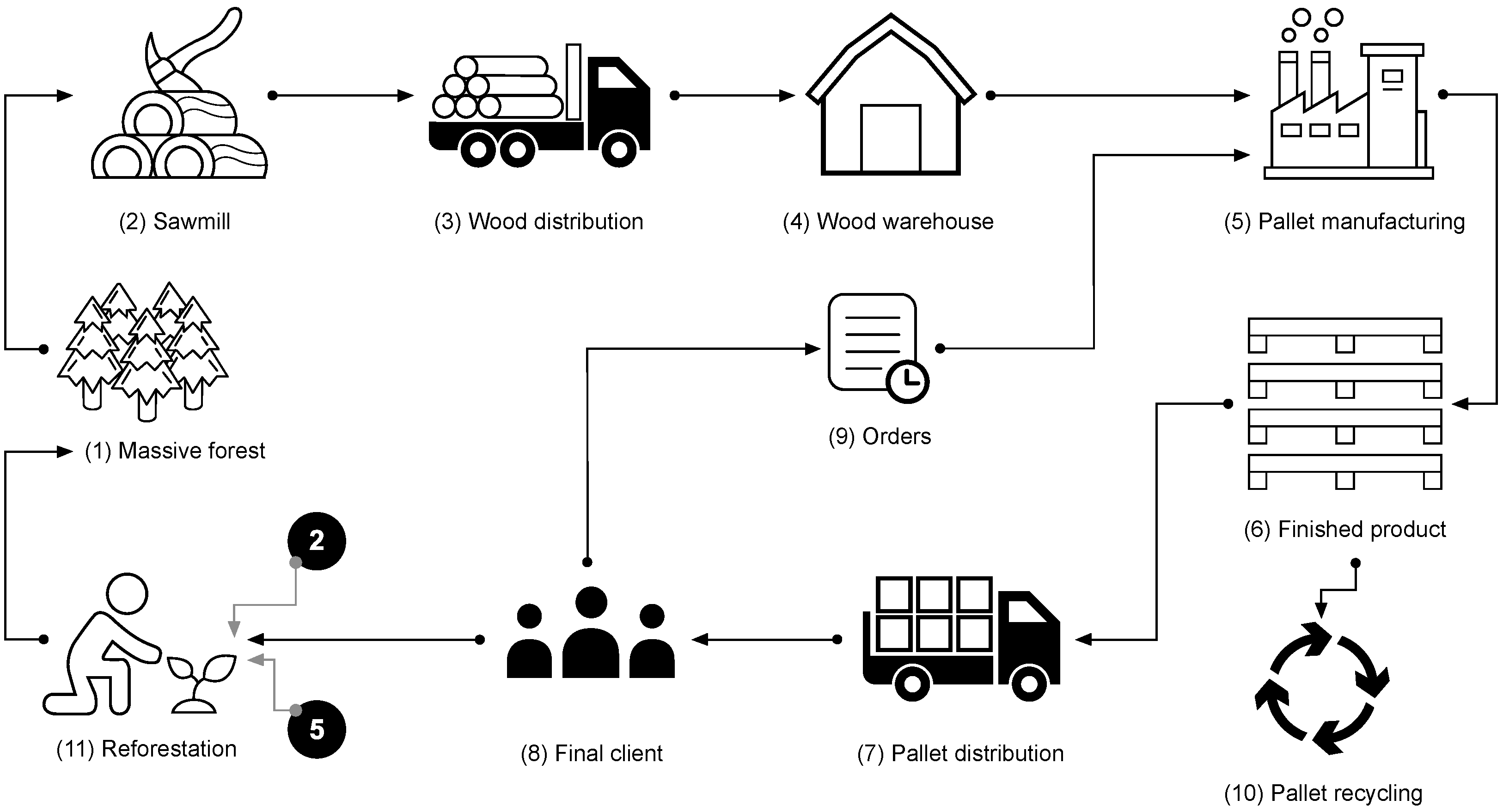
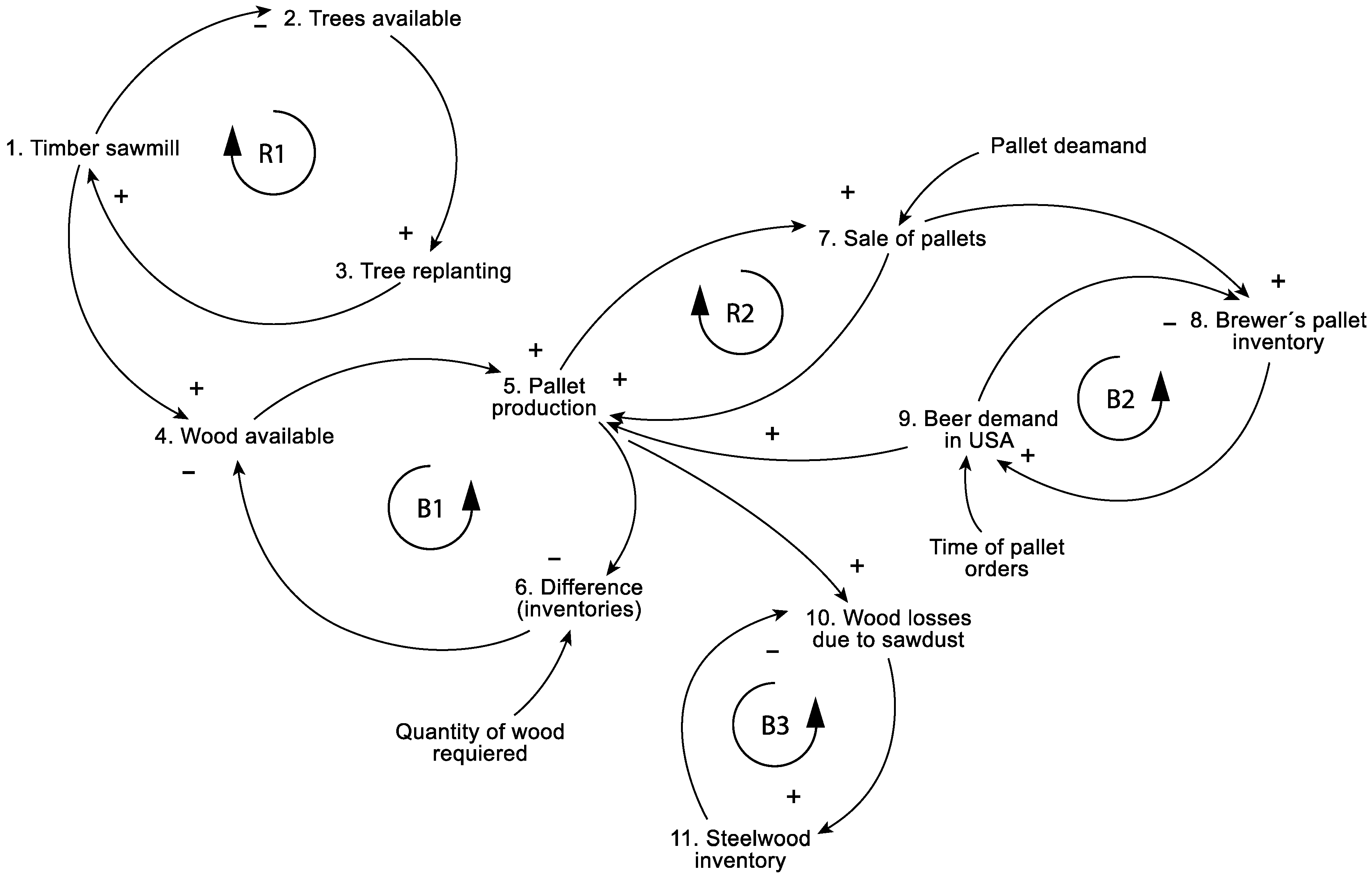
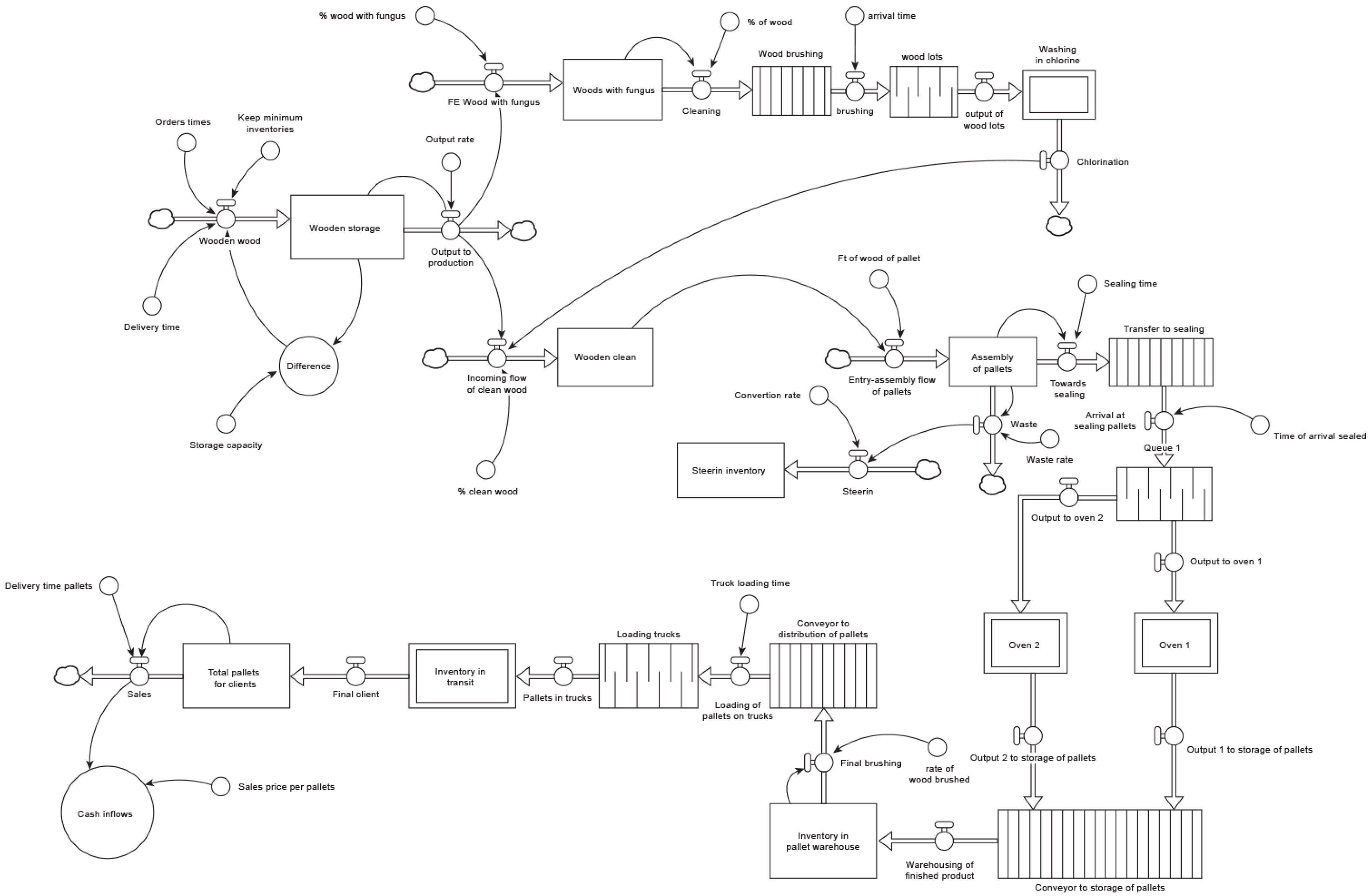
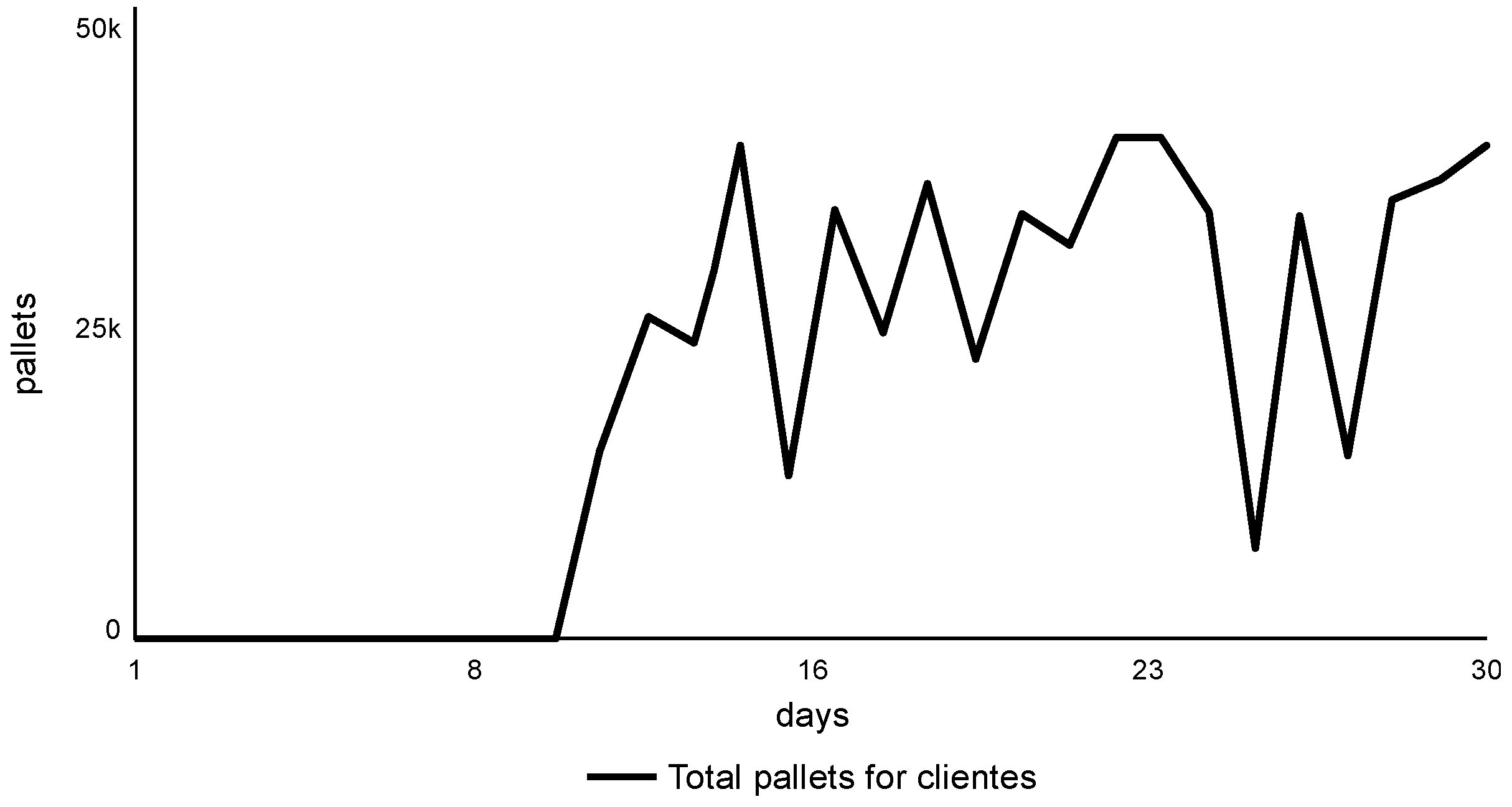
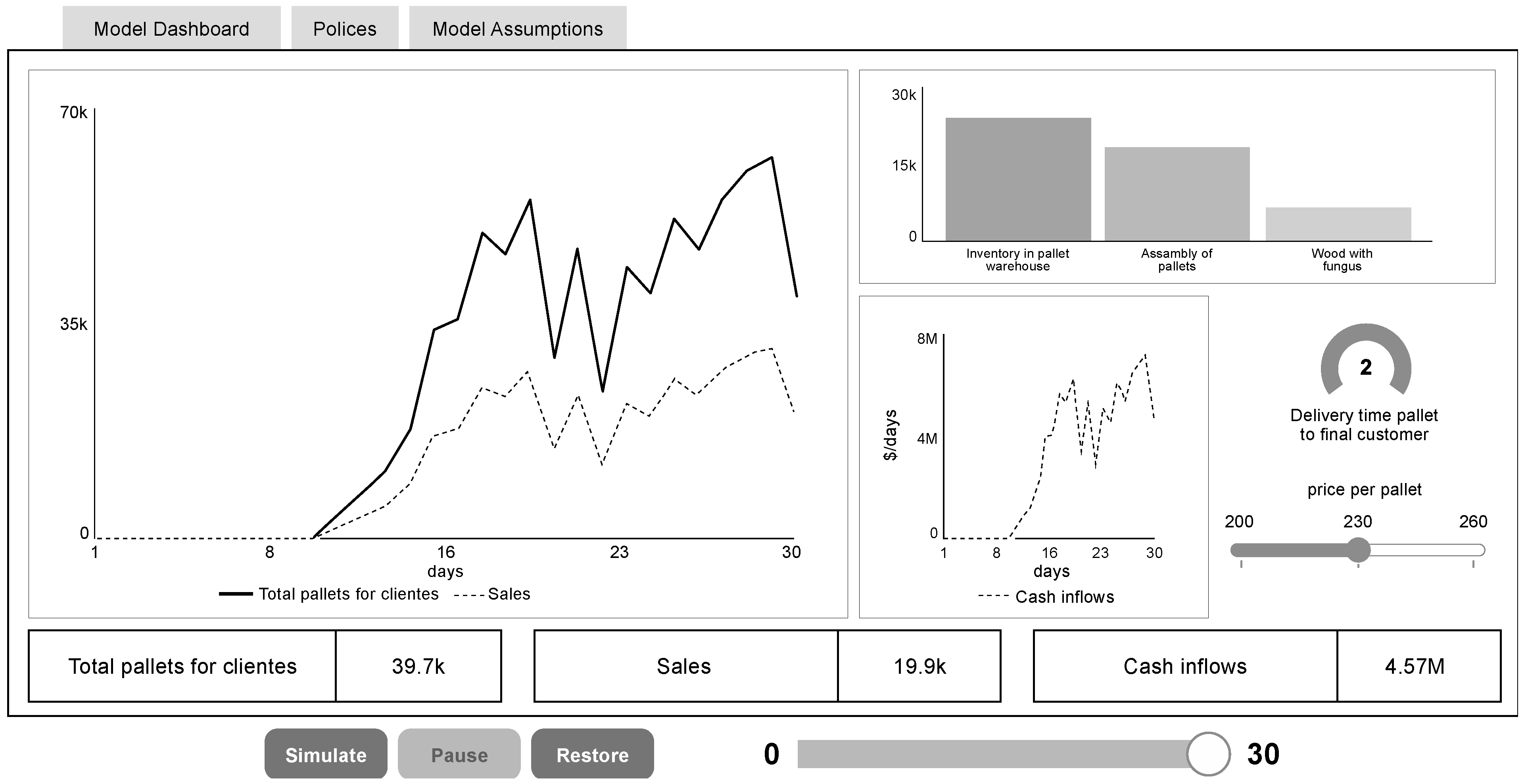
| Author (s) | Novelty | Study Effectiveness |
|---|---|---|
| [3] | Founder of the dynamics system methodology | Applied methodology of different business environments; the methodology is the basis of the proposed construction for the industrial sector. |
| [4,6] | Use of the systemic thought as support for the causal diagram construction | Variable and parameter complexity analysis from the systemic approach; bases for the selection of variables and their relationship presented in different R and B loops. |
| [7] | Guide for using Stella Architect software version 3.3 | Contributions on the use of Stella Architect Software for simulation, sensitivity analysis, design, and development of the graphical user interface. |
| [8] | Set up the logics in which the methods of Euler, Runge Kuta of order 2 and 4 function | Use of the iterative numerical resolution of differential equations (Euler and compared with Runge–Kutta). |
| [9,10,19,25] | Validation methods | Offer different validation methods of system dynamics models. |
| [11] | Study of qualitative scenarios | Theoretical basis to understand the exogenous and endogenous variable behavior in qualitative environments. |
| [12,13] | Use of the multicriteria method for the selection of the best scenarios | Selection of the most critical variables to apply a multicriteria decision making TOPSIS and FUCA. |
| [14,26,27,28] | Mathematical models and metaheuristic algorithms | Using mathematical and metaheuristic models applied in the supply chain and manufacturing under a sustainable approach. |
| [15] | Causal diagram development for the health sector analysis | Proposal of the causal R and B models to represent the complexity of the hospital system of the Province of Quebec, Canada. |
| [16] | Graphical user interface | Design of graphical user interface with combinatorial optimization problems. |
| [5,18,19,29] | Initial contributions of system dynamics methodologyMethodologies with different applications in businesses using validation technique models. | Basis of theoretical and practical application in different environments, such as the supply chain analysis projects. |
| [21,22,23] | Empirical support studies to develop causal loops, simulating optimistic/pessimistic scenarios from current ones and their validation in the pallet manufacturing business | Developed a simulation model to compare scenarios in terms of time of the provider service and internal and global operation costs. Designing closed causal loops and use of simulation as supported tools developed to help logistics decisions in organizations under different scenarios. |
| Criteria | WS | WF | … | CI |
|---|---|---|---|---|
| Objective | Max/Min | Max/Min | … | Max/Min |
| Weight | Whole Value 0 and 1 | Value between 0 and 1 | … | Whole Value 0 and 1 |
| Alternative 1 | ||||
| Alternative 2 | ||||
| … | ||||
| Alternative 15 |
| Multicriteria Method: TOPSIS | WS | WF | WC | AP | IPW | SI | TPC | CI | ||
|---|---|---|---|---|---|---|---|---|---|---|
| Max/ Min | Min | Min | Max | Max | Min | Min | Max | Max | ||
| Ranking | R | 0.1 | 0.1 | 0.15 | 0.15 | 0.1 | 0.05 | 0.15 | 0.2 | |
| 5 | 0.4592 | C-1 | 13,055 | 3463 | 184,505 | 10,625 | 14,209 | 20 | 38,071 | 8,185,775 |
| 4 | 0.4926 | C-2 | 40,274 | 1424 | 235,469 | 15,777 | 15,223 | 33 | 39,176 | 9,428,340 |
| 3 | 0.5407 | C-3 | 7611 | 3795 | 255,872 | 17,139 | 22,816 | 40 | 39,719 | 9,993,869 |
| 2 | 0.5109 | C-4 | 40,274 | 1175 | 257,681 | 17,701 | 16,619 | 43 | 40,488 | 8,268,623 |
| 1 | 0.7651 | C-5 | 13,055 | 986 | 269,594 | 17,738 | 20,396 | 47 | 39,493 | 9,557,924 |
| Multicriteria Method: FUCA | WS | WF | WC | AP | IPW | SI | TPC | CI | ||
|---|---|---|---|---|---|---|---|---|---|---|
| Max/ Min | Min | Min | Max | Max | Min | Min | Max | Max | ||
| Ranking | Weight Sum | 0.1 | 0.1 | 0.15 | 0.15 | 0.1 | 0.05 | 0.15 | 0.2 | |
| 5 | 4.20 | C-1 | 13,055 | 3463 | 184,505 | 10,625 | 14,209 | 20 | 38,071 | 8,185,775 |
| 4 | 3.50 | C-2 | 40,274 | 1424 | 235,469 | 15,777 | 15,223 | 33 | 39,176 | 9,428,340 |
| 3 | 2.65 | C-3 | 7611 | 3795 | 255,872 | 17,139 | 22,816 | 40 | 39,719 | 9,993,869 |
| 2 | 2.55 | C-4 | 40,274 | 1175 | 257,681 | 17,701 | 16,619 | 43 | 40,488 | 8,268,623 |
| 1 | 1.90 | C-5 | 13,055 | 986 | 269,594 | 17,738 | 20,396 | 47 | 39,493 | 9,557,924 |
| Multicriteria Method: TOPSIS | WS | WF | WC | AP | IPW | SI | TPC | CI | ||
|---|---|---|---|---|---|---|---|---|---|---|
| Max/ Min | Min | Min | Max | Max | Min | Min | Max | Max | ||
| Ranking | R | 0.1 | 0.1 | 0.15 | 0.15 | 0.1 | 0.05 | 0.15 | 0.2 | |
| 11 | 0.5282 | C-1 | 13,055 | 3463 | 184,505 | 10,625 | 14,209 | 20 | 38,071 | 8,185,775 |
| 3 | 0.5978 | C-2 | 40,274 | 1424 | 235,469 | 15,777 | 15,223 | 33 | 39,176 | 9,428,340 |
| 4 | 0.5964 | C-3 | 7611 | 3795 | 255,872 | 17,139 | 22,816 | 40 | 39,719 | 9,993,869 |
| 5 | 0.5942 | C-4 | 40,274 | 1175 | 257,681 | 17,701 | 16,619 | 43 | 40,488 | 8,268,623 |
| 1 | 0.6793 | C- 5 | 13,055 | 986 | 269,594 | 17,738 | 20,396 | 47 | 39,493 | 9,557,924 |
| 14 | 0.4640 | P-1 | 13,055 | 3642 | 315,978 | 20,826 | 25,041 | 52 | 17,321 | 4,640,803 |
| 8 | 0.5400 | P-2 | 13,055 | 1545 | 289,314 | 18,122 | 20,105 | 40 | 19,490 | 5,669,753 |
| 12 | 0.5178 | P-3 | 7611 | 956 | 141,879 | 9676 | 5869 | 11 | 17,840 | 5,678,938 |
| 15 | 0.4223 | P-4 | 7611 | 3798 | 119,253 | 8342 | 3733 | 6 | 15,400 | 4,530,354 |
| 13 | 0.5008 | P-5 | 40,274 | 970 | 147,734 | 9781 | 10,598 | 13 | 28,813 | 7,931,546 |
| 10 | 0.5334 | O-1 | 40,274 | 1630 | 128,049 | 8732 | 10,434 | 10 | 39,144 | 10,200,449 |
| 7 | 0.5596 | O-2 | 40,274 | 2015 | 209,242 | 13,909 | 12,923 | 23 | 39,733 | 8,655,700 |
| 9 | 0.5375 | O-3 | 13,055 | 6250 | 225,344 | 14,497 | 15,727 | 26 | 44,684 | 10,870,243 |
| 6 | 0.5796 | O-4 | 7611 | 4779 | 237,114 | 15,709 | 15,378 | 29 | 42,713 | 8,953,504 |
| 2 | 0.6069 | O-5 | 40,274 | 2057 | 240,789 | 16,438 | 19,298 | 32 | 46,733 | 10,906,535 |
| MCDM Method: FUCA | WS | WF | WC | AP | IPW | SI | TPC | CI | ||
|---|---|---|---|---|---|---|---|---|---|---|
| Max Min | Min | Min | Max | Max | Min | Min | Max | Max | ||
| Ranking | General Value | 0.1 | 0.1 | 0.15 | 0.15 | 0.1 | 0.05 | 0.15 | 0.2 | |
| 13 | 9.45 | C-1 | 13,055 | 3463 | 184,505 | 10,625 | 14,209 | 20 | 38,071 | 8,185,775 |
| 7 | 7.15 | C-2 | 40,274 | 1424 | 235,469 | 15,777 | 15,223 | 33 | 39,176 | 9,428,340 |
| 3 | 6.10 | C-3 | 7611 | 3795 | 255,872 | 17,139 | 22,816 | 40 | 39,719 | 9,993,869 |
| 4 | 6.15 | C-4 | 40,274 | 1175 | 257,681 | 17,701 | 16,619 | 43 | 40,488 | 8,268,623 |
| 1 | 5.15 | C-5 | 13,055 | 986 | 269,594 | 17,738 | 20,396 | 47 | 39,493 | 9,557,924 |
| 10 | 8.35 | P-1 | 13,055 | 3642 | 315,978 | 20,826 | 25,041 | 52 | 17,321 | 4,640,803 |
| 8 | 7.50 | P-2 | 13,055 | 1545 | 289,314 | 18,122 | 20,105 | 40 | 19,490 | 5,669,753 |
| 12 | 9.30 | P-3 | 7611 | 956 | 141,879 | 9676 | 5869 | 11 | 17,840 | 5,678,938 |
| 15 | 12.00 | P-4 | 7611 | 3798 | 119,253 | 8342 | 3733 | 6 | 15,400 | 4,530,354 |
| 14 | 9.65 | P-5 | 40,274 | 970 | 147,734 | 9781 | 10,598 | 13 | 28,813 | 7,931,546 |
| 11 | 8.85 | O-1 | 40,274 | 1630 | 128,049 | 8732 | 10,434 | 10 | 39,144 | 10,200,449 |
| 9 | 8.15 | O-2 | 40,274 | 2015 | 209,242 | 13,909 | 12,923 | 23 | 39,733 | 8,655,700 |
| 5 | 6.75 | O-3 | 13,055 | 6250 | 225,344 | 14,497 | 15,727 | 26 | 44,684 | 10,870,243 |
| 6 | 6.80 | O-4 | 7611 | 4779 | 237,114 | 15,709 | 15,378 | 29 | 42,713 | 8,953,504 |
| 2 | 5.50 | O-5 | 40,274 | 2057 | 240,789 | 16,438 | 19,298 | 32 | 46,733 | 10,906,535 |
| Optimistic Scenarios | MCDM1 = TOPSIS | MCDM2 = FUCA | ||
|---|---|---|---|---|
| Position | Value | Position | Value | |
| O-1 | 10 | 0.5335 | 11 | 8.85 |
| O-2 | 7 | 0.5596 | 9 | 8.15 |
| O-3 | 9 | 0.5375 | 5 | 6.75 |
| O-4 | 6 | 0.5796 | 6 | 6.80 |
| O-5 | 2 | 0.6069 | 2 | 5.50 |
Disclaimer/Publisher’s Note: The statements, opinions and data contained in all publications are solely those of the individual author(s) and contributor(s) and not of MDPI and/or the editor(s). MDPI and/or the editor(s) disclaim responsibility for any injury to people or property resulting from any ideas, methods, instructions or products referred to in the content. |
© 2023 by the authors. Licensee MDPI, Basel, Switzerland. This article is an open access article distributed under the terms and conditions of the Creative Commons Attribution (CC BY) license (https://creativecommons.org/licenses/by/4.0/).
Share and Cite
Lagarda-Leyva, E.A.; Acosta-Quintana, M.P.G.; Portugal-Vásquez, J.; Naranjo-Flores, A.A.; Bueno-Solano, A. System Dynamics and Sustainable Solution: The Case in a Large-Scale Pallet Manufacturing Company. Sustainability 2023, 15, 11766. https://doi.org/10.3390/su151511766
Lagarda-Leyva EA, Acosta-Quintana MPG, Portugal-Vásquez J, Naranjo-Flores AA, Bueno-Solano A. System Dynamics and Sustainable Solution: The Case in a Large-Scale Pallet Manufacturing Company. Sustainability. 2023; 15(15):11766. https://doi.org/10.3390/su151511766
Chicago/Turabian StyleLagarda-Leyva, Ernesto A., María Paz Guadalupe Acosta-Quintana, Javier Portugal-Vásquez, Arnulfo A. Naranjo-Flores, and Alfredo Bueno-Solano. 2023. "System Dynamics and Sustainable Solution: The Case in a Large-Scale Pallet Manufacturing Company" Sustainability 15, no. 15: 11766. https://doi.org/10.3390/su151511766
APA StyleLagarda-Leyva, E. A., Acosta-Quintana, M. P. G., Portugal-Vásquez, J., Naranjo-Flores, A. A., & Bueno-Solano, A. (2023). System Dynamics and Sustainable Solution: The Case in a Large-Scale Pallet Manufacturing Company. Sustainability, 15(15), 11766. https://doi.org/10.3390/su151511766










